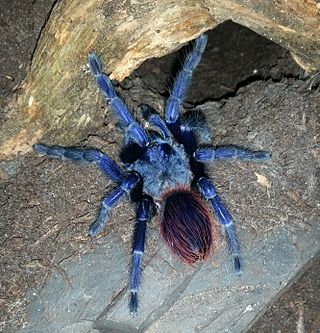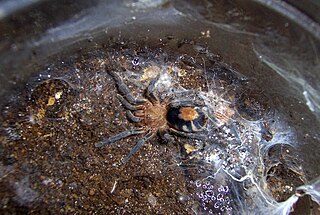
The Goliath birdeater belongs to the tarantula family Theraphosidae. Found in northern South America, it is the largest spider in the world by mass and body length, and second to the giant huntsman spider by leg span. It is also called the Goliath tarantula or Goliath bird-eating spider; the practice of calling theraphosids "bird-eating" derives from an early 18th-century copper engraving by Maria Sibylla Merian that shows one eating a hummingbird. Despite the spider's name, it rarely preys on birds.

The Chilean rose tarantula, also known as the rose hair tarantula, the Chilean fire tarantula, or the Chilean red-haired tarantula, is probably the most common species of tarantula available in American and European pet stores today, due to the large number of wild-caught specimens exported cheaply from their native Chile into the pet trade. The species is also known from Bolivia and Argentina.

Avicularia avicularia, sometimes called the pinktoe tarantula, is a species of tarantula native from Venezuela, Guyana, Suriname, French Guiana and Trinidad and Tobago to Peru, Bolivia and Brazil. This species is sometimes called the Guyana pinktoe, or South American pinktoe.

Pamphobeteus is a genus of tarantulas that was first described by Reginald Innes Pocock in 1901. It includes some of the largest spiders in the world. They are found in South America, including the countries of Peru, Bolivia, Ecuador, Brazil, Colombia and Panama.

Tarantulas comprise a group of large and often hairy spiders of the family Theraphosidae. As of August 2022, 1,040 species have been identified, with 156 genera. The term "tarantula" is usually used to describe members of the family Theraphosidae, although many other members of the same infraorder (Mygalomorphae) are commonly referred to as "tarantulas" or "false tarantulas". Some of the more common species have become popular in the exotic pet trade. Many New World species kept as pets have setae known as urticating hairs that can cause irritation to the skin, and in extreme cases, cause damage to the eyes.

Megaphobema robustum, known as the Colombian giant tarantula or Colombian giant redleg, was first described by Anton Ausserer in 1875. Found in the tropical rainforests of Colombia and Brazil near logs, it has a span of 6 to 8 inches and will eat crickets, other large insects, small lizards and mice.

Lasiocyano is a genus of tarantulas. As of June 2023, it was a monotypic genus with the sole species Lasiocyano sazimai, synonym Pterinopelma sazimai, known as the Brazilian blue, iridescent blue or Sazima's tarantula. The species was first described by Rogério Bertani, Roberto Hiroaki Nagahama and Caroline Sayuri Fukushima in 2011. In 2012, it became the first Brazilian species to appear on the International Institute for Species Exploration's top 10 new species list. The species name honors Ivan Sazima, a Brazilian zoologist who was the first to collect exemplars of the species. It is now considered an endangered species owing to smuggling and a shrinking habitat.
Ephebopus uatuman also known as the Emerald Skeleton Tarantula is a tarantula native to Brazil. It was first described by Lucas, Silva and Bertani in 1992. It is named after the Uatuman River.

Thrixopelma ockerti, commonly known as the Peruvian Flame Rump or Flame Rump Tree Spider, is a species of tarantula and the type species of the genus Thrixopelma. It is endemic to Peru and was first described by Gunter Schmidt in 1994. It is named ockerti after the collector Roland Ockert.

Phormictopus auratus, commonly known as the Cuban bronze tarantula, is a species of tarantula endemic to Cuba. It is found in the provinces of Camagüey, Las Tunas and Holguín. It was first described by David Ortiz and Rogério Bertani in 2005, and was named after golden hairs found in this species, auratus meaning golden in latin.
Ornithoctonus aureotibialis is a tarantula species in the Ornithoctonus genus, it was first described by Volker von Wirth and Boris F. Striffler in 2005. It is named for the Latin, aureus being "golden" and tibia. Because of the gold or orange coloured line of hair in the tibiae of the legs in subadult and adult females and subadult males. Its common name is Thailand Golden Fringe, as the name may suggest it is found in Thailand, Myanmar and Malaysia. It is sometimes kept as a pet, and are captive bred.

Monocentropus balfouri is a tarantula in the Monocentropus genus, it was first described by Reginald Innes Pocock in 1897. This tarantula is also called Socotra Island Blue Baboon Tarantula, usually shortened to Blue Baboon Tarantula. This spider is named after its collector Isaac Bayley Balfour. It is found in Socotra Island, hence the common name. This tarantula is terrestrial and an opportunistic burrower. Like many tarantulas, M. balfouri can be kept as a pet, although it is not a beginner species.
Aphonopelma moreae otherwise known as Mexican jade fuego tarantula is a spider first described by Andrew Smith in 1995. It is named after Barbara Moore, who is the President of the American Arachnological Society. As its common name may suggest it is found in Mexico, in the state of Sonora, south of Yécora. This tarantula is sometimes kept as pet, though the price is usually very high. This is a terrestrial tarantula, which sometimes digs intricate burrows.
Acanthoscurria insubtilis also known as the Bolivian black velvet tarantula, is a spider which was first described by Eugène Simon in 1892. It is found in Bolivia, with some reports also stating in Brazil, though it is mainly in the Bolivian Rainforests.
Eucratoscelus pachypus also known as the Tanzania stout leg baboon tarantula or the stout leg tarantula, was first described by Gunter Schmidt and Volker von Wirth in 1990. It is found in Tanzania, hailing from arid parts, and is an obligate burrower.

Harpactira cafreriana otherwise known as the Cape copper baboon or amber baboontarantula spider was first described by Charles Athanase Walckenaer in 1837. It is found in South Africa, being terrestrial or semi-fossorial in nature.
Cyriocosmus leetzi also known as the Columbian dwarf tiger or Venezuelan dwarf beauty tarantula is a tarantula which was first described by Fabian Vol in 1999. As its common names may suggest it is found in Colombia, with some people stating it is also found in Venezuela.

Cyriocosmus perezmilesi otherwise known as the Bolivian dwarf beauty tarantula is a spider which was first described by Radan Kaderka in 2007. It was named in honor of Dr. Fernando Pérez-Miles, and is a fossorial tarantula. As its common name aptly states it is found in Bolivia.
Pamphobeteus fortis also known as the Colombian giant copperhead or Colombian giant brown tarantula is a tarantula which was first described by Anton Ausserer in 1875. As its common name aptly states it is found in Colombia, Venezuela and Panama.
Pamphobeteus vespertinus also known as the Ecuadorian red bloom tarantula is a tarantula first described in 1889 in Eugène Simon. They are found in the arid areas of Ecuador, and they are terrestrial tarantulas.












